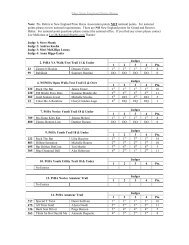2011 Official Rule Book - New England Pinto Horse Association
2011 Official Rule Book - New England Pinto Horse Association
2011 Official Rule Book - New England Pinto Horse Association
You also want an ePaper? Increase the reach of your titles
YUMPU automatically turns print PDFs into web optimized ePapers that Google loves.
REGisTRaTion<br />
C4. Breeding stock Division Requirements<br />
A. The Breeding Stock Division is provided to record the<br />
bloodlines of animals with color documented in its pedigree<br />
which is solid colored or which lacks sufficient body marking to<br />
be registered in the Color Division of the Registry.<br />
B. Qualifications<br />
Solid color <strong>Horse</strong>s, Ponies or Miniatures are eligible under<br />
the following conditions:<br />
1. Solid color animals with documented color breed<br />
registered ancestry (within two generations).<br />
2. Solid colored animals registered with an approved<br />
outcross color breed.<br />
3. Animals that have two or more <strong>Pinto</strong> characteristics.<br />
4. Animals originally registered as Breeding Stock now<br />
qualifying under the current Color division requirements<br />
must be reclassified and are no longer eligible to be shown<br />
in Breeding Stock classes.<br />
C5. Color Patterns<br />
A. General<br />
1. The ideal <strong>Pinto</strong> possesses a 50-50 color pattern<br />
distribution. However, the patterns and markings are<br />
extremely varied and are found in many colors ranging<br />
from the predominantly white to the predominantly colored.<br />
2. An all-white horse, pony, or miniature, with a dark cheek,<br />
cap, spotted face or colored area on body is a <strong>Pinto</strong>.<br />
3. For registration purposes, only one pattern will be<br />
designated on the Registration Certificate.<br />
B. Tobiano (Toe-be-yah’-no)<br />
1. Head Color Characteristics<br />
a. Least amount of white<br />
b. Dark eyes, but blue eyes are still possible<br />
c. Can be solid dark or minimal normal white markings<br />
and a white body<br />
2. Body Color Characteristics<br />
a. Cross the top line<br />
b. Cover one or both flanks<br />
c. Spots can be oval, round<br />
d. Extend over neck and chest<br />
e. Body can be almost solid color<br />
3. Body White Characteristics<br />
a. Body can be almost all white<br />
b. Does usually cross back between withers and tail<br />
4. Leg Color Characteristics<br />
a. Usually white on all four (4) legs, at minimum below<br />
hock and knees<br />
b. Spots of dark color along the coronet band are often<br />
found (Coronet Spots)<br />
5. Color/White Edges<br />
a. Crisp delineation between colored spots and white<br />
b. Border between color/white can be pigmented skin<br />
with white hair, i.e. shadow, halo bluish cast (blue<br />
zone)<br />
6. General Characteristics<br />
a. Multi-colored tail hair<br />
b. Small spots of color within larger white body white,<br />
usually have a “blue zone” (Ink Spots or Paw Prints)<br />
c. Must have at least one (1) Tobiano parent.<br />
36 <strong>2011</strong> PtHA <strong>Rule</strong> <strong>Book</strong><br />
Tobiano Pattern Examples



